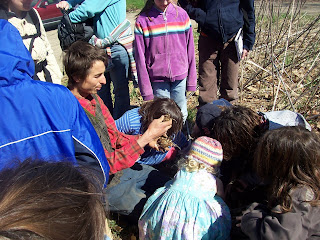Sometimes, on this MooseBoots journey, things just click. The Universe presents things that seem to fit so neatly into our plans and desires. This weekend, I went to the
5th Annual Knap-In at the University of Southern Maine. The events certainly exceeded my wildest expectations.
First, the is a whole geography-anthropology program that I never knew existed. I have lived near this university nearly my entire life, have been into this building hundreds of times, but never knew about the gem hidden on the thrid floor of Bailey Hall. In addition to the flint knapping room, there were several others open for the event. Each focused on a different topic - the zooarcheology room, the Amazon room, the Smuttynose room, the rock room, and the demonstration room were one of the seniors in the program presented some of the work she has been doing, in Africa, on the Swahili culture and archeology.
I had the benefit of hanging around the whole time. Every couple of hours, after their dance classes ended, one of the girls would join me and I would visit each room again. I did not get to spend enough time with the flint-knappers, but I certainly got a great deal out of the rest. My girls did too - which as homeschoolers is every bit as important ... it also doesn't hurt for them to see me learning and interested in learning. Each room was monitored by students from the program. Each of the students with which I spoke was intelligent, engaging, and truly excited about the work they were doing.
The favorite for the girls was easily the zooarcheology room. There were several displays - one showing the evolution of humans complete with replica skulls, one showing bird bones, one showing large animal bones, and one showing bones dug from dig last summer on
Smuttynose Island.
Little Big sister was pretty excited about visiting the Amazon room. She is terribly interested in snakes. They had on display three anaconda skins. The largest only one-third the size of the largest snakes found in the Amazon. In addition, they had baskets, necklaces, bags, blow darts, bows, arrows, and ocelot, and many more pieces.
The Smuttynose room was filled with artifacts recovered from the island. Students travlled there last summer, and will be returning this summer, to dig. The island was used between the 1600s and the 1800s as a fishing station. It is well known for the
murders that tooks place there in 1873. The student I talked to first was sorting smoking pipes. He explained that the diameter of the hole in the stem could be used to date the pipes ... earlier pipes had larger holes. He also showed a few fish hooks and explained that they got smaller through time because the fish sizes decreased because of over--fishing. In addition to the artifacts from the fishing industry during this time period, they also found "pre-historic" stone tools and implements.
Unfortunately, I did not get to stay for the entire presentation on the Swahili, but what I saw was impressive. Wendy stayed for the duration and told me I missed the best parts. When I left, she was just beginning to show photos of the dig site where she was working. She spoke at length about the trade route used in the early period of the Swahili people on the East Coast of Africa and their interactions with the Arabic, Indian, and Chinese traders. The presentation was outstanding.
The two rooms I wished to spend most of my time were the stone room, where a student explained about the different types of rocks on display, and the flint-knapping room. I was not able to spend nearly enough time in either. I have recognmized that I know nothing about rocks and minerals. I feel a strong need to learn and this was enough to really fuel the fire. When I did finally get to the flint-knapping room for any length of time, it was nearing the end of the event. The expert knappers were busy, but I asked to circle with my four girls near him. He took a liking to Little Fire Faery and immediately started working exclusively with her ... to the detriment of the rest of us. He carefully showed her the techniques, but did not let her do as much as she would have liked. We did bring home the start of a nice arrow head and some rock flakes.



Of course, during the day, in spite of the fierce wind, there was a demonstration fo friction fire starting. I have started a fire with a bowdrill exactly one time despite numerous attempts. I did learn a bit by watching someone else use one. My notch was probably too big and I was too excited to let the coal strengthen. I also added a bit of understanding about fire board materials, etc.
As far as material, it seemed like a great opportunity to move my MooseBoots forward. In the end, however, there was just too much. Of course, our homeschooling philosophy is ... throw stuff at them and see what sticks, at very least they will remember seeing the material before when they are ready of absorb it. Maybe it applies to me too!


















